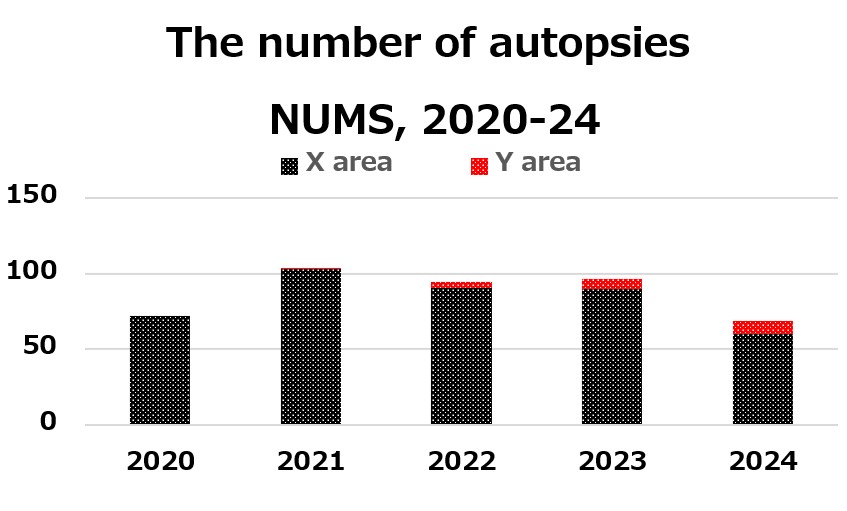Welcome to the department of Legal Medicine in NUSM. It was founded in 1951. Since then, we have carried out social mission and responsibility, applying the principles and knowledge of medical science in the field of law. The medico-legal investigation of death is the top priority in our specialty. Forensic autopsy is the main duty and involves the collection of evidence from the deceased to determine the cause and manner of death. In order to maintain communal well-being, we manage 100 cases per year upon request from the police department. The researches in our department are strongly associated with forensics. The followings are some of the research topics currently under investigation.
English Page
Autopsy

In our department, we perform around 100 autopsies per year.
Alcohol dehydrogenase in alcohol-related organ disorder
Impact of alcohol consumption induces global healthcare problem, accounting for 3.3 million deaths. Ethanol is detected in blood or urine in approximately 30-40% of sudden unexpected deaths. During alcohol metabolism, alcohol dehydrogenase (ADH) oxidizes ethanol to acetaldehyde. ADH has several isozymes, among which Class III alcohol dehydrogenase (Adh5) has the highest Km of ethanol among all ADH isozymes. These isozymes participate in systemic alcohol metabolism in chronic alcohol consumption or high blood alcohol concentration. In addition, Adh5 is the ancestral enzyme distributed in almost all mammal tissues and involved in S-nitrosoglutathione (GSNO) reducing activity. However, the effectiveness of GSNO reducing activity during chronic alcohol consumption still needs elucidation.
We hypothesize that alcohol-related organ disorder might be due to Adh5 participation in the local metabolism of ethanol, which may generate secondary metabolites, resulting in tissue damages. In addition, the primary physiological role of Adh5 may be inhibited by chronic alcohol consumption due to its participation in alcohol metabolism. This study was supported by the Japan Society for the Promotion of Science (JSPS) KAKENHI Grant (#16K09223, #19H04038 and #20K09512). We will proceed with the elucidation of the pathophysiology of alcoholic liver disease, alcoholic osteoporosis, and sudden death related to alcohol withdrawal using mice from multiple perspectives in collaboration with Nippon Medical School and Tokushima University.
Biomechanical analysis of fatal injury
Rupture of cardiac sac may be observed in cases involving cardiopulmonary resuscitation. Previously, we reported a case in which chest compression was applied under acute cardiac tamponade that ruptured the cardiac sac, resulting in massive hemothorax. We hypothesized that the diameter of the heart sac increased with acute hemopericardium, and chest compression was applied that increased the stress applied to the heart sac, resulting in stress concentration on a specific part of the heart sac. We are now analyzing the hypothesis by the finite element analysis method using computer simulation. This study was supported by the JSPS KAKENHI Grant (#16K09222). The method used in this study is expected to elucidate the mechanism of cervical spinal cord injury due to cervical hyperextension or cardiac rupture due to blunt trauma.
Comparison between postmortem CT and autopsy findings
Over the past several decades, postmortem CT is increasingly performed to obtain supplementary or complementary information for autopsy. These images are useful for guiding autopsy, as well as providing additional information for the assessment of cause of death. In Japan, along with the increasing social demands for investigating the cause of death, the forensic practitioners, medical practitioners, police, and legal professionals are widely using postmortem images. We have previously reported several significant articles comparing between postmortem CT and autopsy findings that have contributed to the development of early stages of forensic imaging. We are now collaborating with Tsukuba Medical Examiner's office to do research for postmortem imaging. In the near future, we would like to consider installing postmortem multi-detector CT in NUSM.
Personal identification and paternity testing using new DNA analysis technology.
Personal identification or paternity testing is significant if the deceased is unknown in the forensics. DNA polymorphism technology, especially the emergence of STR, SNA and DIP inspection methods, has made great progress in recent years. We will focus on the development of brand-new applications that can be analyzed under severe conditions such as degradation of DNA. In addition, we have used micro RAN to analyze the cause of death from cardiovascular diseases, alcoholic liver disease, etc. These studies might contribute more to society in death investigations, criminal investigations, airplane accidents, and massive disasters.
Office Address
Department of Legal Medicine, Nihon university school of medicine
30-1, OYAGUCHI KAMI-CHO
ITABASHI-KU, TOKYO 173-8610 JAPAN